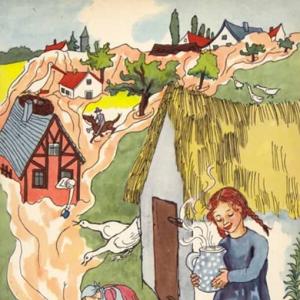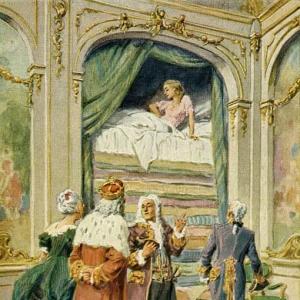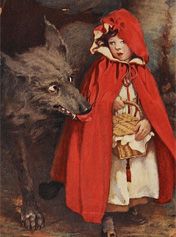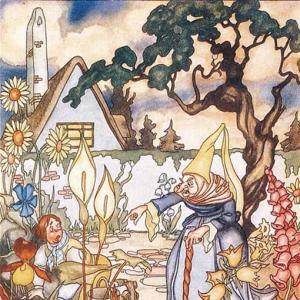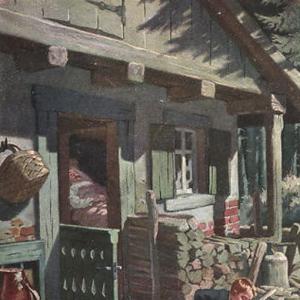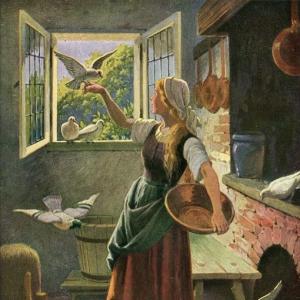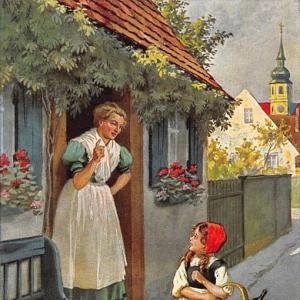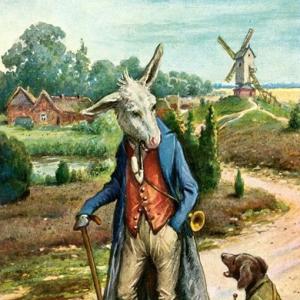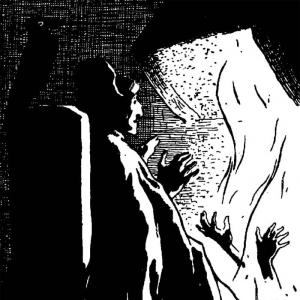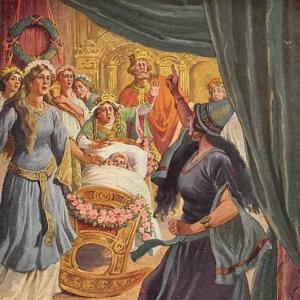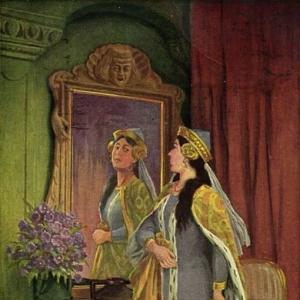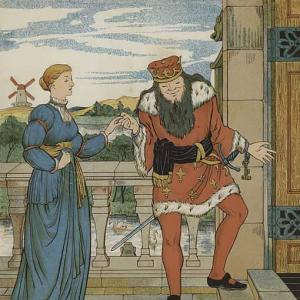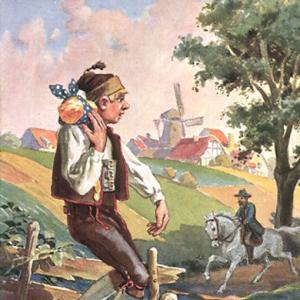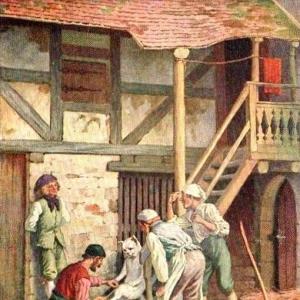Reading time for children: 9 min
There was once on a time a mother who had three daughters, the eldest of whom was rude and wicked, the second much better, although she had her faults, but the youngest was a pious, good child. The mother was, however, so strange, that it was just the eldest daughter whom she most loved, and she could not bear the youngest. On this account, she often sent the poor girl out into the great forest in order to get rid of her, for she thought she would lose herself and never come back again. But the guardian-angel which every good child has, did not forsake her, but always brought her into the right path again. Once, however, the guardian-angel behaved as if he were not there, and the child could not find her way out of the forest again. She walked on constantly until evening came, and then she saw a tiny light burning in the distance, ran up to it at once, and came to a little hut. She knocked, the door opened, and she came to a second door, where she knocked again. An old man, who had a snow-white beard and looked venerable, opened it for her; and he was no other than St. Joseph. He said quite kindly, „Come, dear child, seat thyself on my little chair by the fire, and warm thyself. I will fetch thee clear water if thou art thirsty; but here in the forest, I have nothing for thee to eat but a couple of little roots, which thou must first scrape and boil.“
St. Joseph gave her the roots. The girl scraped them clean, then she brought a piece of pancake and the bread that her mother had given her to take with her; mixed all together in a pan, and cooked herself a thick soup. When it was ready, St. Joseph said, „I am so hungry; give me some of thy food. The child was quite willing, and gave him more than she kept for herself, but God’s blessing was with her, so that she was satisfied. When they had eaten, St. Joseph said, „Now we will go to bed. I have, however, only one bed, lay thyself in it. I will lie on the ground on the straw.“ – „No,“ answered she, „stay in your own bed, the straw is soft enough for me.“ St. Joseph, however, took the child in his arms, and carried her into the little bed, and there she said her prayers, and fell asleep. Next morning when she awoke, she wanted to say good morning to St. Joseph, but she did not see him. Then she got up and looked for him, but could not find him anywhere; at last she perceived, behind the door, a bag with money so heavy that she could just carry it, and on it was written that it was for the child who had slept there that night. On this she took the bag, bounded away with it, and got safely to her mother, and as she gave her mother all the money, she could not help being satisfied with her.
The next day, the second child also took a fancy to go into the forest. Her mother gave her a much larger piece of pancake and bread. It happened with her just as with the first child. In the evening she came to St. Joseph’s little hut, who gave her roots for a thick soup. When it was ready, he likewise said to her, „I am so hungry, give me some of thy food.“ Then the child said, „You may have your share.“ Afterwards, when St. Joseph offered her his bed and wanted to lie on the straw, she replied, „No, lie down in the bed, there is plenty of room for both of us.“ St. Joseph took her in his arms and put her in the bed, and laid himself on the straw.
In the morning when the child awoke and looked for St. Joseph, he had vanished, but behind the door she found a little sack of money that was about as long as a hand, and on it was written that it was for the child who had slept there last night. So she took the little bag and ran home with it, and took it to her mother, but she secretly kept two pieces for herself.
The eldest daughter had by this time grown curious, and the next morning also insisted on going out into the forest. Her mother gave her pancakes with her — as many as she wanted, and bread and cheese as well. In the evening she found St. Joseph in his little hut, just as the two others had found him. When the soup was ready and St. Joseph said, „I am so hungry, give me some of thy food,“ the girl answered, „Wait until I am satisfied. Then if there is anything left thou shalt have it.“ She ate, however, nearly the whole of it, and St. Joseph had to scrape the dish. Afterwards, the good old man offered her his bed, and wanted to lie on the straw. She took it without making any opposition, laid herself down in the little bed, and left the hard straw to the white-haired man. Next morning when she awoke, St. Joseph was not to be found, but she did not trouble herself about that. She looked behind the door for a money-bag. She fancied something was lying on the ground, but as she could not very well distinguish what it was, she stooped down, and examined it closely, but it remained hanging to her nose, and when she got up again, she saw, to her horror, that it was a second nose, which was hanging fast to her own. Then she began to scream and howl, but that did no good. She was forced to see it always on her nose, for it stretched out so far. Then she ran out and screamed without stopping till she met St. Joseph, at whose feet she fell and begged until, out of pity, he took the nose off her again, and even gave her two farthings. When she got home, her mother was standing before the door, and asked, „What hast thou had given to thee?“ Then she lied and said, „A great bag of money, but I have lost it on the way.“ – „Lost it!“ cried the mother, „oh, but we will soon find it again,“ and took her by the hand, and wanted to seek it with her. At first she began to cry, and did not wish to go, but at last she went. On the way, however, so many lizards and snakes broke loose on both of them, that they did not know how to save themselves. At last they stung the wicked child to death, and they stung the mother in the foot, because she had not brought her up better.
 Learn languages. Double-tap on a word.Learn languages in context with Childstories.org and Deepl.com.
Learn languages. Double-tap on a word.Learn languages in context with Childstories.org and Deepl.com.Backgrounds
Interpretations
Adaptions
Summary
Linguistics
„Saint Joseph in the Forest“ is a fairy tale collected by the Brothers Grimm, Jacob and Wilhelm Grimm, in their famous compilation of Germanic folk tales known as „Grimms‘ Fairy Tales“ or „Children’s and Household Tales“ (in German: „Kinder- und Hausmärchen“). The first edition of this compilation was published in 1812, and it contained 86 stories. Over the years, the collection expanded, reaching a total of 210 stories in the final 1857 edition.
The Brothers Grimm were prominent German scholars, linguists, and cultural researchers who sought to preserve the oral tradition of folk tales, which they considered an essential part of their national heritage. Many of the stories they collected were passed down through generations and existed only in the form of storytelling or in fragments.
„Saint Joseph in the Forest“ shares common elements with other folk tales from around the world, such as the theme of three siblings embarking on quests, the test of character, and the role of divine intervention. The figure of St. Joseph in the story represents a guardian, helper, or divine presence who provides support and guidance to the characters, rewarding good deeds and punishing bad ones.
Although St. Joseph is primarily known for his role in Christianity as the earthly father of Jesus Christ, in this particular story, he appears as a more general representation of goodness and divine assistance. By incorporating the figure of St. Joseph, the Brothers Grimm may have intended to connect the tale with Christian values and create a familiar character for their audience.
„Saint Joseph in the Forest“ is a fairy tale with multiple interpretations that can be derived from its themes, symbols, and characterizations. Here are some possible interpretations:
The importance of kindness and generosity: The youngest daughter’s kind heart and generosity towards St. Joseph is rewarded with a heavy bag of money. This could be interpreted as the story emphasizing the importance of treating others with kindness and sharing with those in need, as it can bring about blessings and good fortune in one’s life.
The consequences of greed and selfishness: The eldest daughter’s selfishness and lack of empathy for St. Joseph result in her punishment with a second nose and a measly two farthings. This could be interpreted as a cautionary tale that demonstrates the consequences of being self-centered and greedy, which can lead to misfortune and suffering.
The impact of upbringing on children’s behavior: The mother’s favoritism and poor parenting choices are highlighted in the story, as she nurtures the wickedness of her eldest daughter and treats the youngest unfairly. The consequences of her actions become evident when the lizards and snakes attack them, resulting in the death of her wicked daughter and her own injury. This interpretation stresses the importance of raising children with love, fairness, and good moral values to ensure they grow into compassionate and responsible adults.
The theme of divine intervention and justice: The story features St. Joseph, a saintly figure, who rewards and punishes the characters based on their behavior. The youngest daughter’s goodness is rewarded, while the eldest daughter’s wickedness is punished, demonstrating the concept of divine intervention and the notion that justice will ultimately prevail.
The significance of inner qualities over appearances: The mother’s favoritism towards her wicked eldest daughter may be attributed to superficial qualities like beauty or charm, while she fails to recognize the inner goodness of her youngest daughter. This interpretation highlights the importance of valuing a person’s inner qualities, such as kindness and generosity, rather than judging them solely based on appearances.
There have been several adaptations of the fairy tale „Saint Joseph in the Forest“ from Brothers Grimm. Here are some examples.
„St. Joseph in the Forest“ (1914): This is a silent film adaptation of the fairy tale directed by Ernst Lubitsch. It features the story of a young boy who runs away from home and meets Saint Joseph in the forest. The film was praised for its cinematography and visual effects.
„St. Joseph in the Forest“ (1934): This is a German film adaptation of the fairy tale directed by Gustav Ucicky. The film follows the story of a young boy who meets Saint Joseph in the forest and is given three magical gifts. The film was a commercial success and received positive reviews from critics.
„St. Joseph in the Forest“ (1955): This is a French television adaptation of the fairy tale directed by Jean-Paul Carrère. The film features the story of a young boy who meets Saint Joseph in the forest and is given three magical gifts. The film was well-received by audiences and praised for its cinematography and visual effects.
„Saint Joseph in the Forest“ (2013): This is a children’s book adaptation of the fairy tale written by Becky J. Radtke and illustrated by Deborah A. Hoover. The book follows the story of a young boy who meets Saint Joseph in the forest and is given three magical gifts. The book was praised for its colorful illustrations and engaging storytelling.
„Saint Joseph in the Forest“ (2021): This is a short film adaptation of the fairy tale directed by Rémy Rondeau. The film features the story of a young boy who meets Saint Joseph in the forest and is given three magical gifts. The film was well-received by audiences and praised for its stunning cinematography and special effects.
„Saint Joseph in the Forest“ is a Brothers Grimm fairy tale that tells the story of a mother and her three daughters, each with distinct personalities. The mother favors the eldest, wicked daughter and despises the pious youngest daughter. In an attempt to get rid of the youngest daughter, the mother sends her into the forest, but the girl’s guardian angel always guides her back home. One day, however, the guardian angel seems absent, and the girl finds herself lost in the forest.
As night falls, the youngest daughter finds a hut belonging to St. Joseph. The kind old man offers her a humble meal of roots, which she prepares along with a pancake and bread that her mother had given her. After sharing the meal generously with St. Joseph and insisting he take the only bed, the girl wakes up the next morning to find St. Joseph gone and a heavy bag of money waiting for her. She returns home and gives the money to her mother.
Seeing her sister’s success, the second daughter ventures into the forest and encounters St. Joseph. She shares her food with him, sleeps in his bed alongside him, and wakes to find a small sack of money, which she brings back to her mother while secretly keeping some for herself.
Finally, the wicked eldest daughter goes to the forest, determined to acquire a larger fortune. When she meets St. Joseph, she begrudgingly shares her food, leaves the old man to sleep on the hard straw, and expects a reward the following morning. Instead, she wakes up to find a second nose attached to her face. Desperate, she begs St. Joseph to remove the nose, and he gives her two farthings as well.
When she returns home and lies to her mother about losing a bag of money, the mother insists they go back and look for it. Along the way, they are attacked by lizards and snakes, leading to the death of the wicked daughter and the injury of the mother, who is punished for her poor parenting.
The fairy tale „Saint Joseph in the Forest“ by the Brothers Grimm is rich in linguistic features that contribute to its timeless appeal and moral undertones. Through a close analysis of the text, we can identify several key linguistic elements that are typical of traditional fairy tales, especially those collected by the Brothers Grimm.
Formulaic Structure: The tale begins with the classic „once upon a time“ structure, setting it firmly within the fairy tale genre. This formulaic beginning provides a familiar framework for the audience, signaling that the narrative will explore themes of morality and fantastical events.
Character Archetypes: The characters in the story represent well-defined archetypes. The mother is biased and unkind, the youngest daughter is pious and good, the eldest daughter is rude and wicked, and St. Joseph functions as the wise, benevolent helper. These archetypes allow for clear moral lessons to be conveyed and ensure that the story’s characters are easily understood by the audience.
Moral and Didactic Elements: The narrative incorporates clear moral lessons, a common trait in fairy tales. The story demonstrates the virtues of kindness, generosity, and humility through the youngest daughter’s behavior and the consequences experienced by each of the daughters. The rewarding of the good and the punishment of the wicked underscore the tale’s didactic purpose.
Repetition and Parallelism: The story uses repetition and parallel structures to emphasize its themes and create rhythm. Each daughter goes through a similar series of events when they encounter St. Joseph, highlighting the different outcomes based on their virtues or faults. This repetitive pattern helps reinforce the moral implications of their actions.
Symbolism: The forest, a frequent symbol in fairy tales, represents the unknown and the place of trial and transformation. The light in the distance symbolizes hope and guidance, while the money bags represent the rewards of virtue. The second nose that affixes to the eldest daughter serves as a physical manifestation of her greed and selfishness.
Dialogue and Direct Speech: The use of direct speech brings the characters to life and allows for the expression of their personalities and intentions. St. Joseph’s polite and kind words contrast with the eldest daughter’s self-centered responses, adding depth to their characterizations.
Old-Fashioned Language: The use of archaic language, such as „thee,“ „thou,“ and „art,“ lends the tale an old-world charm and authenticity, immersing the reader in the era from which the tale originated.
The linguistic elements in „Saint Joseph in the Forest“ function collectively to create a narrative that is both engaging and instructive. Through the interplay of structure, archetypes, and language, the Brothers Grimm offer a story that transcends cultural and temporal boundaries, continuing to impart wisdom and entertainment.
Information for scientific analysis
Fairy tale statistics | Value |
|---|---|
| Number | KHM 201 |
| Aarne-Thompson-Uther-Index | ATU Typ 480 |
| Translations | DE, EN |
| Readability Index by Björnsson | 25.8 |
| Flesch-Reading-Ease Index | 86 |
| Flesch–Kincaid Grade-Level | 5.5 |
| Gunning Fog Index | 7.9 |
| Coleman–Liau Index | 6.9 |
| SMOG Index | 7.1 |
| Automated Readability Index | 5.3 |
| Character Count | 5.918 |
| Letter Count | 4.498 |
| Sentence Count | 68 |
| Word Count | 1.167 |
| Average Words per Sentence | 17,16 |
| Words with more than 6 letters | 101 |
| Percentage of long words | 8.7% |
| Number of Syllables | 1.426 |
| Average Syllables per Word | 1,22 |
| Words with three Syllables | 31 |
| Percentage Words with three Syllables | 2.7% |


